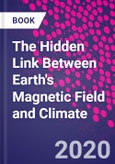The Hidden Link Between Earth's Magnetic Field and Climate offers a new framework of understanding and interpretation for both well-known and less known relations between different geophysical and meteorological variables which can improve the quality of climate modeling. The book reviews the most current research on both current and paleo data to introduce a causal chain of interactions between the geomagnetic field, energetic particles which bombard the Earth's atmosphere, ozone and humidity near the tropopause, and surface temperature.
The impacts of these complicated interactions is not uniformly distributed over the globe, thus contributing to our understanding of regional differences in climatic changes and the asymmetrical ozone distribution over the globe.
Please Note: This is an On Demand product, delivery may take up to 11 working days after payment has been received.
Table of Contents
1. Geomagnetic field origin, spatial-temporal structure and variability2. Variations and co-variation in paleoclimate and paleomagnetic field3. Current understanding about the factors driving Clime variability4. Contemporary evidence for an existing relation between geomagnetic and climatic parameters5. Galactic cosmic rays and solar particles in the Earth's atmosphere6. Energetic particles' impact on the near tropopause ozone and water vapour7. Mechanisms for the geomagnetic influence on climate8. Concluding remarks








